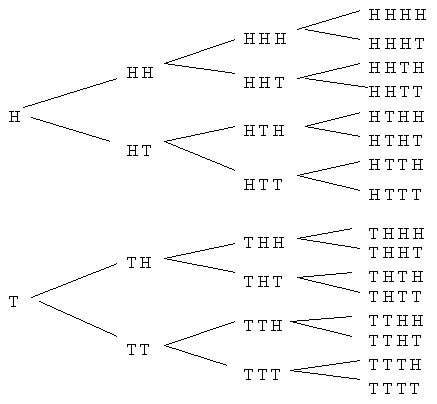How comes 'likely' events happen so rarely?
A fair coin is tossed 10 consecutive times. Which of the following outcomes is most likely?
H H T H T H T T H T
T T T T T T T T T T
Most people believe that the first is more likely than the second. But this is a fallacy. They are equally likely.
People are confusing 'randomness' (the first outcome seems much more 'random' than the second) with probability.
The probability of either of these particular sequences occurring is 1 divided by 1024.
There are two ways to understand this:
One way is to think of all possible sequences. The first coin toss has just 2 outcomes: H or T.
For each of these two outcomes the second coin toss has 2 outcomes. That makes 4 different outcomes for the first two tosses:
H H
H T
T H
T T
For each of these 4 outcomes for the first two tosses there are two
outcomes for the third toss, making 8 in all and for each of those 8
there are 2 outcomes for the fourth toss etc. We can represent these
possible sequences of outcomes using a so-called 'event tree' like this:

In other words every time you add a coin toss you double the number of
possible outcomes. So the total number of possible sequences on the 4th
toss is 2 to the power of 4 (that is 2 x 2 x 2 x 2), the total number
on the 5th toss is 2 to to the power of 5 etc until the total number on
the 10th toss is 2 to the power of 10 which is equal to 1024.
So there are 1024 equally likely outcomes, meaning that each particular
outcome has the probability 1/1024. Since the two sequences are just
two of these particular outcomes each has the probability 1/1024.
The other way to calculate the probability of a specific sequence is
to use the fact that each coin toss is ‘independent’
of the previous one. So, since the probability of getting a T on
the first toss is ½ and the
probability of getting T on the second toss is ½ we conclude
that the
probability of both these outcomes happening is ½
times ½ . Applying
the same argument to the third and subsequent coin tosses we end up
with a probability ½ times ½ times ½ …ten
times, which is 1/1024.
The appearance of randomness in the first sequence compared to the
second (which is the reason why people think the first sequence is more
likely) arises because it 'looks like' lots of other possible
sequences. Specifically, this sequence involves 5 H's and 5 T's and
there are many sequences involving 5 H's and 5T's. In fact, 252 of the
possible 1024 sequences contain exactly 5 H's and 5 T's. This contrasts
with the second sequence --- it really looks 'unique' because there is only one
sequence (this one) involving 10 T's. The probability
of getting a sequence that contains 5 H's and 5 T's is 252/1024 which
is, of course, much higher than the probability of getting a sequence
with 10 T's. But the probability of getting the particular sequence of 5 H's and 5 T's above is still only 1/1024.
Now you hopefully understand why apparently 'likely' events are
actually pretty rare. To appreciate the converse of this (that
incredibly unlikely events happen all of the time) look at this example of a pack of playing cards and the examples here and here.
Norman Fenton
Return to Main Page Making Sense of Probability: Fallacies, Myths and Puzzles
